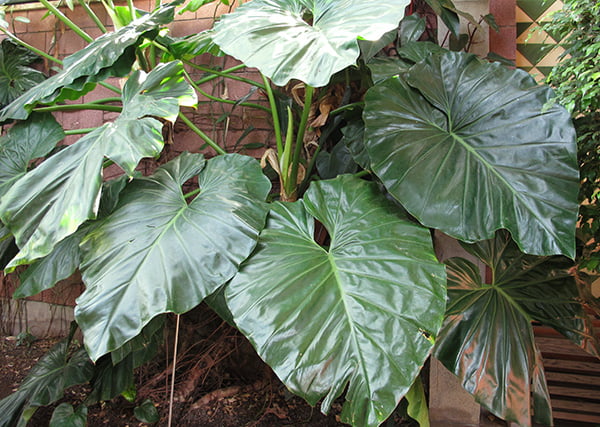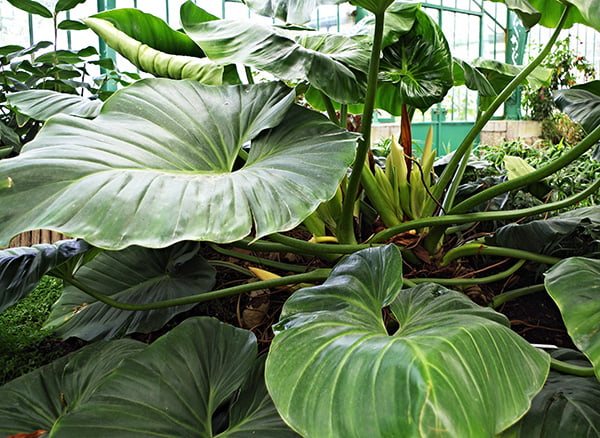If you've got a space to fill - and I mean a BIG space! - then Philodendron Giganteum is your plant! This is a massive, big-leaved plant with bright green, shiny foliage that will make a statement in any space. And even though Philodendron Giganteum is a huge plant, caring for it couldn't be easier! It grows best outdoors, but it can also be grown indoors! Our Philodendron Giganteum care guide below will help keep your plant thriving.
Botanical Name
Common Name
Plant Type
Mature Size
Sun Requirement
Soil Type
Hardiness Zone
Pet Friendly
Philodendron Giganteum
Elephant Ear Philodendron, Yautía Cimarrona, Giant Philo
Tropical
4 to 5 feet tall and 3 feet wide
Bright light
Loose potting soil
9 - 11
No
What Is Philodendron Giganteum?
Philodendron Giganteum is also known as Philodendron Giganteum Elephant Ear, "Giant Philodendron," and "Giant Philo." As its name implies, this plant is enormous, like an elephant's ear. Philodendron Gigantuem is a tropical plant native to South America and is the perfect choice for gardeners looking to fill in a gap.
The heart-shaped green leaves look similar to the leaves of the Elephant Ear plant, and each leaf can grow as big as two feet long! The whole plant will grow over 10 feet tall and 8 feet wide if given the right growing conditions! It can absolutely be grown as a house plant, but it's often planted outdoors.
While most philodendron varieties vine, Philodendron Giganteum grows more like a self-header. This means that its leaves are stacked so closely together that you won't notice much of a stem at all. The leaf stalks tend to hold the plant upright without needing a moss pole for support.
Philodendron Giganteum Care Requirements
Light
As a tropical plant, philodendrons need plenty of bright light - but it needs to be indirect light as well. Remember that philodendrons grow underneath rainforest canopies! They receive lots of light, but it's dappled. The best location for bright, indirect light is a south-facing window. However, an east-facing window is another good option because although your plant will receive direct sunlight in the morning, it's not a harsh light.
Water
It's important not to overwater a Philodendron Giganteum, as they're prone to root rot - and it's a huge plant to have to unpot and dry out if you notice rotting roots! They'll typically need to be watered weekly during the growing season but always check the soil first. When the top inches of the soil feels dry, it is time to water your Philodendron Giganteum. If you feel moist soil, wait another day or two!
Temperature
Like all tropical plants, Philodendron Giganteum needs a warm environment. The ideal temperature range is between 65 and 80 degrees Fahrenheit - which is handy because most households are kept in this temperature range! Keep mindful of areas in your home that might be colder or hotter.
For a healthy Philodendron Giganteum, keep it away from radiators, heating and cooling vents, drafty windows, and fireplaces.
It's important that the temperature around your plant not dip below 55 degrees Fahrenheit as this will cause your Philodendron Giganteum to go dormant and, eventually, die. However, this is not much of a concern if you're growing Philodendron Giganteum as a tropical house plant. However, if you have your plant outdoors, keep an eye on your overnight temperatures and bring it inside if the temperatures dip.

Source: Flickr
Humidity
Since Philodendron Giganteum is a tropical plant, it likes a humid environment. It's best to grow Philodendron Giganteum varieties in a humid area. The ideal air moisture range is between 60% and 80%. If your house is not typically kept that humid, there are ways to boost the air moisture in the space directly around your plant.
Grouping
Plants naturally increase the humidity in the air directly around them. If you have other tropical plants that appreciate humidity, group them together.
Pebble Tray
Fill a tray with pebbles, then fill it with water to just under the top of the pebbles. Place your pot on the pebbles. Water will evaporate from the tray into the air around your plant.
Use A Humidifier
Particularly in dry climates, use a humidifier. You might benefit from a moisture boost as well!
Place Your Plant In The Bathroom
The steam from showers and baths will help your Philodendron Giganteum thrive.
Soil
Philodendron Giganteum will thrive if planted in loose potting soil that is rich in organic matter. The best way to do this is to mix your own soil! Start with a succulent or cactus mix, and add perlite and sphagnum peat moss, mulch, orchid bark, or sterile compost. The perlite will help you achieve well-draining soil, while the peat moss will help your soil retain moisture and release it to the roots slowly. As for the organic matter, use coconut husk or bark for the roots to grip onto, and compost for a nutrition boost!
If you're planting your Philodendron Giganteum outdoors, choose an area with quick-draining soil. Plant it uphill or on a mound, so that excess moisture can easily drain away. Leaf mulch around the base will prevent moisture from draining too quickly.
Fertilization
Fertilization is an optional care requirement for most Philodendrons, but the Philodendron Giganteum is much too large a plant for that! Larger plants need nutritive support! Fertilize Philodendron Giganteum plants twice monthly during the growing season. You can use a liquid fertilizer to get nutrients to the roots fast or opt for a balanced organic fertilizer. Mature compost or worm castings are great options for this.
Pruning
The beauty of this Philodendron plant is its large, bushy, unrestrained growth habit. Pruning it regularly will actually stunt its growth. Only prune Philodendron Giganteum leaves that become diseased or aged.
Repotting
It's best to grow this giant plant outdoors, but that's not always possible. Your potted Philodendron Giganteum actually prefers to be rootbound - which is handy because Philodendron Giganteum repotting often stresses the plant considerably. Wait to repot your Philodendron Giganteum until you notice roots growing out of the drainage holes of its pot. Then, repot it in the early spring. This gives your plant time to adapt before the stress of the growing season.
Propagation
Philodendron Giganteum propagation is a little different from other Philodendron varieties, although it's not any harder! It doesn't have long lengths of stems between leaves like a climbing plant. You'll have to wait until the central stem grows long enough that there is an adequate gap between leaves, and this can take a while! But once you get to that point, propagating Philodendron Giganteum is easy.
Water your Philodendron Giganteum and wait about an hour - this helps soften the aerial roots along the stem. Get your transplant pot ready while you wait!
Cut off the top of the stem at a 45-degree angle, just underneath a node.
Leave the stem cuttings in a shady area for a few hours to dry.
Plant the cutting in the prepared pot, carefully bending the aerial roots until they're within the soil.
Keep the soil moist, and make sure it has plenty of light! You'll notice root growth in a few weeks.

Source: Flickr
Common Problems
One of the reasons Philodendron Giganteum care is so easy is that it doesn't attract many pests and doesn't typically become infected with disease!
Common Pests
Your likely culprits are thrips, mealybugs, or aphids. These are easy enough to prevent and treat with neem oil. If the infestation is particularly bad, you can reach for an insecticidal soap. Fungus gnats also pop up if the soil is being kept too moist. Stop watering for a while, and they should clear away.
Philodendron Giganteum Diseases
Philodendron Giganteum can show signs of root rot - a fungal infection or overwater. Some of the signs include the plant leaves will turn yellow or wilting. Stop watering and let the soil completely dry out to prevent further damage and spread. If possible, unpot the plant and cut away dead roots.
Bacterial infections, such as Pseudomonas leaf spot, can also be tackled by drying the soil out.
Leaf Troubleshooting
These mammoth leaves are good indicators of plant health!
Pale Leaves
If your plant leaves are turning pale, it most likely not receiving enough light. This often accompanies by thin, reaching stems and pale leaves. If this is the case, move your plant to a better location with more sunlight.
Brown Leaves
If the edges of your plant leaves are turning brown and dry, your plant probably needs more water.
Yellow Leaves
Yellow leaves could be a soil of overwatering and will need less water. Check your soil to see if the soil is soggy. If the plant leaves are turning yellow or wilting, it is most likely root rot. Overwatering can cause root rot, and you should check the base of your Philodendron Giganteum and trim off any infected roots.
Dark Patches
If your plant leaves are getting dark patches, it can be caused by cold draft exposure. Trim off the damaged leave and move them to a better location.
Irregular Tan Patches
Irregular tan patches can be a sign of bacterial infection, such as Pseudomonas leaf spot or Erwinia blight. You can determine if it's a bacterial infection by the plant smell, and if it's a bacterial infection, the plant emits an unpleasant odor.
The disease typically affects smaller plants more than larger ones, and it is much less serious on larger Philodendron Giganteum. These bacterial infections can be spread through moisture, gardening tools, and insects. If you suspect that your plant may have a bacteria infection, it's best to isolate it.
Is Philodendron Giganteum Toxic To Pets?
Due to calcium oxalate crystals, Philodendron Giganteum plants are toxic to both humans and pets. If the leaves or stems are ingested, symptoms such as burning and swelling lips and tongue, vomiting, and diarrhea can occur.
FAQ
Is Philodendron Giganteum Rare?
Philodendron Giganteum is not a rare variety of Philodendron species. However, Philodendron Giganteum variegated form is rare. For example, Philodendron Giganteum 'Blizzard' is a very rare form and can be costly.
Does Philodendron Giganteum Climb?
Like its relatives, Philodendron Giganteum enjoys some support as it grows because the aerial roots look to cling to support.
